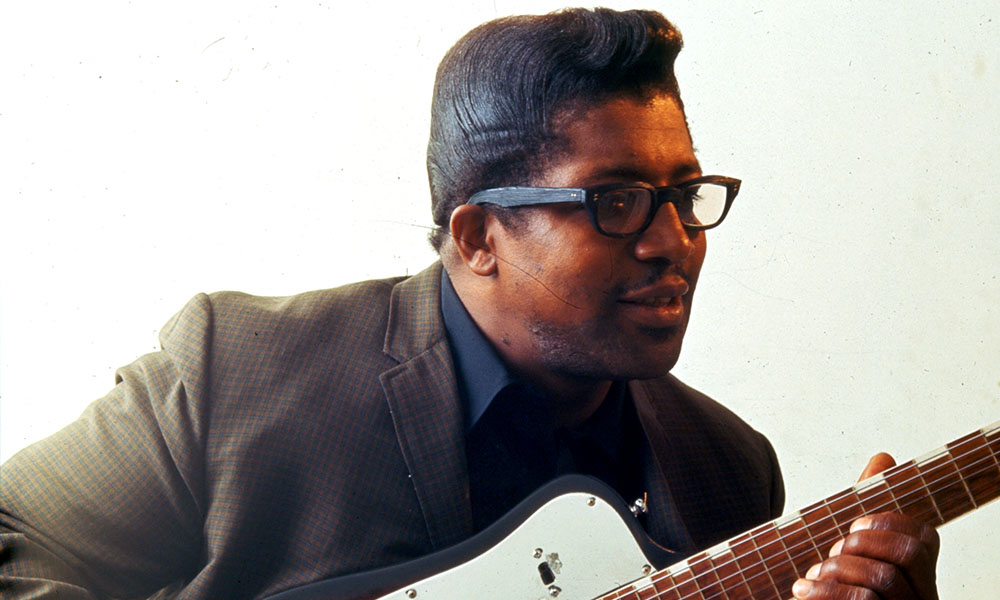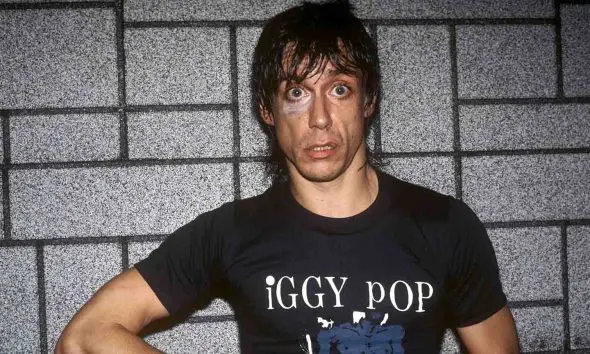Tracing The Bo Diddley Beat
We trace the history of one of the most inspired rhythms in all of popular music.

In the beginning, there was Bo Diddley, and Bo Diddley had the beat. But there’s a lot more to the story than that.
In 1955, Bo Diddley released a daring debut single he named after himself – a sweaty, swampy scorcher defined by a slashing, syncopated groove unlike anything heard in rock ‘n’ roll before. In the process, he laid down a template for generations to come. Rockers started putting their own spin on the “Bo Diddley beat” almost immediately, and the phenomenon continues unabated to this day. Over the years, everybody from The Who and The Rolling Stones to U2 and Tom Petty cranked out their own variation on/homage to Bo’s signature rhythm.
But even though he made the beat famous to the point that it’s become inseparable from his stage name, the singer/guitarist born Ellas Otha Bates in McComb, Mississippi did not invent it.
The beat’s beginnings
West coast bandleader Johnny Otis didn’t harness the beat on record until after Bo broke through, but he claimed to have first played it in the early 1940s when he was drumming for “Count” Otis Matthews & The Oakland House Rockers. “He told me to do… what he called [a] ‘shave and a haircut six bits beat’ and keep beatin’ it,” Otis once told Wayne Jancik. He also said he heard it when he saw a prison work gang pounding it out with their hammers while building railroad tracks.
Neither the Count nor the chain gang ever put the beat on wax, but Chicago drummer and bandleader Red Saunders beat Bo to the punch in 1952 with his single “Hambone.” Most of the track is propelled by polyrhythmic hand-slapping, but right in the middle, the drums deliver the beat in question in no uncertain terms. And like Diddley’s game-changing debut single, the lyrics are derived from the old nursery rhyme “Hush, Little Baby.”
But all that hand-slapping on the Saunders recording is part of a tradition just as deep as that of the lyric. Hambone, also known as the Juba dance, is an African American cultural phenomenon that goes all the way back to the days of slavery. Enslaved Africans brought the rhythm from their homeland to the plantations of the American South. It came from the Yoruba people of West Africa, but the Yoruban diaspora had long since extended to Cuba as well, where the beat evolved into the rumba clave crucial to Afro-Cuban music.
Back home, the rhythm would have been played on a drum. But the plantation owners, fearful of their forced laborers sending secret, subversive messages to each other through drumming, forbade the instruments. In place of the drums, the transplanted Africans developed a series of dances based around slapping their hands against each other and against other body parts. In a development not dissimilar to the way capoeira came about in Brazil, the practice of “pattin’ Juba” was born. By the time singing was added to the mix in the 19th century, the tradition was better known as hambone. And that’s where Red Saunders (alongside “Count” Otis and countless unrecorded others) comes in.
Early adopters
Hand jive was a later variation on hambone that became a hit in the 1950s partly due to Johnny Otis’s 1958 song “Willie and the Hand Jive.” Otis had released records since the late 1940s with nary a hint of the hambone beat, so it seems like a good bet that he was at least emboldened to bring it to the rock ‘n’ roll world by his buddy Bo’s success. Otis said that Bo once half-jokingly took him to task for the similarities between their songs, but Otis was having none of it: “I said to ’im, ‘You ever heard “Hambone?”’ And he said, ‘Ssssh!’”
Whatever the case, when the Checker 45 “Bo Diddley” arrived in April of 1955 it sounded utterly original to rock ‘n’ roll audiences. Bo chomps out the groove on his guitar, with a tremolo effect giving his riffs an otherworldly vibe while the drums and Jerome Green’s maracas create an ecstatic explosion of polyrhythm. It was completely different from the six-string blueprint Chuck Berry would start hashing out with his first singles just a few months later, but just as full of sensuality and wild abandon.
The song was such a sensation that covers started popping up just weeks later, from Jean Dinning’s fairly faithful rendition to a bizarre big-band mambo version by The Joe Reisman Orchestra.
Even Buddy Holly had a go at it, in one of his earliest sessions with producer Norman Petty. The cover wouldn’t be released until after Holly’s death, but Holly was very much alive when “Not Fade Away” came out in 1957. All these years later it remains one of the most beloved adaptations of the Bo Diddley beat, with The Crickets’ wordless backup vocals accentuating the rhythm and Jerry Allison providing the basis of the beat by hitting a cardboard box. Over the years, “Not Fade Away” probably inspired at least as many covers as “Bo Diddley.” In 1958 even guitar hero Duane Eddy (no stranger to tremolo himself) joined the party, with his Bo-influenced instrumental hit “Cannonball.”
Of course, the syncopated tattoo that propelled Bo’s first single wasn’t the only move in his playbook, but he became inextricably associated with it. And while the beat occupied only a small percentage of his early output, he trotted out a vital variation on it for his third single, the lust-soaked “Pretty Thing,” and again in 1957 for the spookily sexy “Mona.” Both would be covered by loads of rock and blues artists, especially in the 1960s, when his music helped change the world.
The big Bo boom
In the first half of the 1960s, both the British Invasion bands and their U.S. counterparts were wowed by the wonder of the 1950s Chess Records catalog (Chuck Berry, Muddy Waters, Howlin’ Wolf, et al.). Their covers of those tunes and their Chess-inspired originals became the next rock ‘n’ roll wave to dominate the planet. Bo Diddley’s classic sides for Chess subsidiary Checker were a crucial part of the equation.
The Beatles, The Searchers, and other British bands were playing Bo Diddley tunes on the now-legendary Hamburg club circuit of the early 60s. In February of 1964, a bunch of scruffy kids calling themselves The Rolling Stones had their first big hit (and their first U.S. single) with a gritty take on “Not Fade Away” nearly as stripped-down as the original. A couple of years later they’d slip the beat into their own “Please Go Home,” adding a little psychedelic sauce. The UK version of The Animals’ self-titled 1964 debut LP even led off with “The Story of Bo Diddley” a quirky, five-and-a-half-minute piece where Eric Burdon delivers a spoken account of Bo’s innovations and influence on ‘60s Brits, over backing that sounds just like you’d expect.
Not only is the feral fury of The Pretty Things’ 1964 debut single, “Rosalyn,” powered by a Bo Diddley beat, the band named itself after one of his songs. Van Morrison’s “Mystic Eyes” leads off the U.K. edition of his band Them’s 1965 debut album, Angry Young Them. The band had decamped to England by that time, and a stroll past a Nottingham graveyard reportedly inspired what came off like a cross between “Pretty Thing” and William Butler Yeats. Pete Townshend wrote The Who’s hambone-ready hit “Magic Bus” in 1965 when the band was cutting its first album, but they didn’t record it until 1968.
Across the Atlantic in that era, you’d find a pre-fame Harry Nilsson working as The Foto-Fi Four, writing and releasing 1964’s “Stand Up and Holler,” a novelty song about The Beatles driven by plenty of Diddley-esque drumming. The Byrds hopped on the train with the Jackie DeShannon-penned “Don’t Doubt Yourself, Babe” from their 1965 debut LP, Mr. Tambourine Man, adding some Bo tremolo to their signature 12-string sound.
With their one-off project The Strangeloves, hit songwriters/producers Bob Feldman, Richard Gottehrer, and Jerry Goldstein scored big in 1965 with the primal slam of “I Want Candy,” which would become a huge hit all over again in a 1982 Bow Wow Wow cover version. But rock wasn’t the period’s only outlet for the Bo beat, as a listen to Smokey Robinson & The Miracles’ “Mickey’s Monkey” and The Supremes’ “When the Lovelight Starts Shining Through His Eyes” makes plain. If you squint hard enough, it might even be possible to imagine a link between that groove and Motown’s signature “You Can’t Hurry Love” rhythm.
Bo’s beat goes on
The beat, as they say, goes on. Iggy Pop’s feral snarl bounced off it on The Stooges’ proto-punk classic “1969” (and again years later on his celebrated solo tune “Lust for Life”). So, the punks had no problem adopting it for their own either – see The Clash’s “Rudie Can’t Fail” and The Damned’s “Anti-Pope” for confirmation.
The same situation held true when post-punk came around. The Fall’s frontman, Mark E. Smith, a man scarcely known for tossing around compliments, once told Uncut, “All these bloody groups have tried to imitate him but no one sounds anything like him.” Naturally The Fall put their hat in the ring too, with “Dice Man,” among others.
Key New Wave inspirations like Brian Eno and David Bowie had trod the territory in the mid-‘70s (see “Blank Frank” and “Panic in Detroit,” respectively). So, when New Wave came to the forefront, a veritable Diddleyfest ensued. There was Elvis Costello’s “Lover’s Walk,” Talking Heads’ “Ruby Dear,” The Police’s “Deathwish,” The dB’s “Amplifier,” The Soft Boys’ “Wey Wey Hep Uh Hole” – The Jesus and Mary Chain even had a tune called “Bo Diddley is Jesus,” with a beat to back up their declaration.
The immortal groove has always been present on the classic rock end of the spectrum too, from Tom Petty (“A Mind with a Heart of Its Own”) and Bruce Springsteen (“She’s the One”) to REO Speedwagon (“Don’t Let Him Go”) and Guns N’ Roses (“Mr. Brownstone”).
Throughout the 70s and 80s, the Bo beat found its way into plenty of Top 40 hits too. Neil Sedaka’s “Bad Blood,” Shirley and Company’s “Shame, Shame, Shame,” U2’s “Desire,” George Michael’s “Faith,” and Ace Frehley’s cover of Hello’s “New York Groove” all brought the hand-jive bump to the US pop charts.
The influence has unavoidably extended into the 21st century. From hits like KT Tunstall’s “Black Horse and the Cherry Tree” and Rihanna’s “If It’s Lovin’ That You Want” to cutting-edge alt-pop tracks of the 2010s like Tune-Yards’ “Water Fountain” and St. Vincent’s “Bring Me Your Loves,” the old hambone rhythm never stopped stirring things up. And in some realm beyond our own, the man who made it famous is looking on and laughing his butt off.
On Twitter, Matty Karas’s The Bo Diddley Beat is a great resource to explore.












